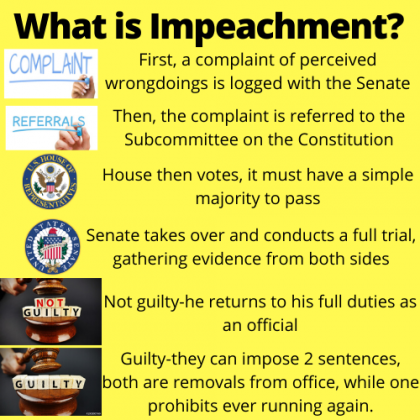With everything that has been going on since Trump took the oath of president, there has been one common denominator in the entire event, the word “impeachment.” Most everybody knows that the House of Representatives Democrats announced two articles of impeachment against President Donald Trump for abuse of power and obstruction of congress. However, what some people do not know, is what impeachment actually means.
When a president is impeached, it does not mean he is automatically kicked out of office. In terms of impeachment proceedings, it depends on the constituents’ behavior and actions.
According to the National Center for Constitutional Studies, “an impeachment begins when an official behaves in a manner which the people believe disqualifies him from further public service. A complaint requesting an impeachment investigation of that official is lodged with the House of Representatives. That request may either be general in its scope or it may delineate specific offenses; it may be requested in a petition filed by individual citizens or on the request of a single Representative, a group of Representatives, or the President.”
Once the complaint is filed, it is referred to the House Judiciary Committee who then forwards it to the Subcommittee on the Constitution. The Subcommittee then investigates and if the complaints hold any merit, the Articles of Impeachment are prepared.
Once the Articles of Impeachment are prepared, they are forwarded to the full Judiciary Committee for a vote. If the vote passes the Judiciary Committee, then the House votes on them. The Articles can be approved by simple majority – 218 out of 435 votes. If it is disapproved, the Articles die at that juncture. If they get approved, then, they are sent to the Senate.
When the Senate takes over, it basically becomes a full-scale trial there with Senators sitting as the jury. The hearing typically consists of the defendant and prosecution presenting evidence. Once all the evidence is heard, a vote is done. It takes a two-thirds vote to find the impeached official guilty. Meaning, if less than two-thirds of the Senators do not believe sufficient evidence was given to prove the Article of Impeachment, the official is acquitted and free to return to his office and full privileges and restored.
However, if the two-thirds decide the defendant is guilty, then the Constitution allows the Senate to impose one of two penalties on the guilty party; remove him from that specific office, or remove him from office and prohibit them from ever holding office in the future.
In more simpler terms, an impeachment is basically an accusation that starts an investigation. Just like any criminal court, the investigation could lead to an indictment, then jury trial, then a possible conviction with jail time.

